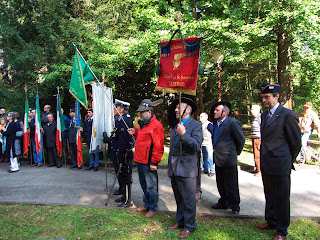Hazelnut spread that became a worldwide favourite
 |
| Nutella served with crusty bread is a popular snack in Italy and around the world |
Michele Ferrero, who died in 2015 aged 89, owned the Italian chocolate manufacturer Ferrero SpA, the second largest confectionery producer in Europe after Nestlé.
He was the richest individual in Italy, listed by the Bloomberg Billionaires index in 2014 as the 20th richest person in the world. The wealth of Michele and his family was put at $20.4 billion, around 14.9 billion euros.
Ferrero is famous for such brands as Ferrero Rocher, Mon Cheri, Kinder and Tic Tacs. But, it could be argued, none of those names would probably exist had it not been for Nutella.
The chocolate and hazelnut spread came into being after Michele, who was born in the small town of Dogliani in Piedmont, inherited the Ferrero company from his father, Pietro, who died in 1949 only three years after setting up in business from his bakery in nearby Alba.
 |
| Michele Ferrero became the richest man in Italy |
A creamy, spreadable version was produced in 1951 under the name 'Supercrema' but it was after Michele decided to add palm oil to the recipe that the product really took off. Renamed Nutella, and sold in a jar, it rolled off the production line at the factory in Alba for the first time on 20 April 1964.
Nutella was instantly popular and remains so more than 50 years later. Ferrero now produces 365,000 tons of Nutella every year in 11 factories around the world, with its biggest markets in Germany, France and Italy.
The 50th anniversary of Nutella's invention was commemorated with a stamp issued by Poste Italiane in 2014. One fan of the product instigated World Nutella Day, which is celebrated by devotees on 5 February each year.
Building on Nutella's success, Ferrero created the Ferrero Rocher pralines, Kinder bars and Kinder Eggs and a host of other brands. What had begun as a small provincial chocolate factory turned into Italy's most valuable privately-owned company with sales of around 8 billion euros ($9 billion), selling its products in 53 countries.
Michele had a reputation for maintaining good working conditions for Ferrero's 22,000 employees. A fervent Catholic, he had a Madonna placed in every factory and office belonging to the company.
He eventually made his home in Monte Carlo but commuted to Alba by helicopter every day, playing an active role in creating new products until only a few years before his death.
Giovanni Ferrero, the youngest of Michele's two sons, is now the company's Chief Executive. His brother, Pietro, was unfortunately killed in a cycling accident in South Africa in 2011.
 |
| Alba's Romaneque Duomo |
Alba, situated about 65 kilometres south-east of Turin, is a beautiful town famed for the production of white truffle, peaches and elegant wines, including Barbera and Barolo. The town dates back to Roman times and has been fought over through history by Hungary, France, Spain and Austria among others. Its partisans won a Gold Medal for Military Valour during the Second World War after liberating the town from Mussolini's Fascists. Notable buildings include the Romanesque Duomo, built in the 12th century, restructured in the 15th century and further restored in the 19th century.
Travel tip:
Michele Ferrero's home town, about a half-hour drive from Alba to the south-west, Dogliani nestles among vineyards and woods of hazel trees. Wine production plays an important role in the town's economy, in particular the Dolcetto di Dogliani red, which is made only from Dolcetto grapes grown within a small, clearly defined area, of which the yield is strictly controlled to maintain the wine's high value. The late 19th century church of San Quirico e Paolo is impressive. Visitors to the area before Christmas can witness the town's Presepio Vivente, in which local people enact the nativity scene on the nights of 23 and 24 December.
(Photo of Nutella by A Kniesel CC BY-SA 3.0)
(Photo of Duomo in Alba by Pippo-B CC BY-SA 3.0)
Home





